Centauri Dreams
Imagining and Planning Interstellar Exploration
Into the ‘Brown Dwarf Desert’
A newly discovered brown dwarf dubbed OGLE-2015-BLG-1319 is significant on several fronts, not the least of which is how it was found. Not only are we dealing here with another instance of gravitational microlensing, where the light of a background star is affected by a foreground object in ways that give us information about the closer star, but this instance of microlensing saw two space telescopes working together to make sense of the event, the first time a microlensing event has been observed by two space telescopes and from the ground.
The space-based instruments in question are the Spitzer and Swift telescopes, whose combined observations give us different magnification patterns rising from the same event. Spitzer observed the binary system containing the brown dwarf in July of 2015 from its perch about 1 AU away from the Earth. Swift, in low Earth orbit, also saw the system in late June of that year, marking its first microlensing observation. The first notification of the event came from the Optical Gravitational Lens Experiment (OGLE) in Chile, and it was also observed by the Microlensing Observations in Astrophysics (MOA) collaboration in New Zealand.
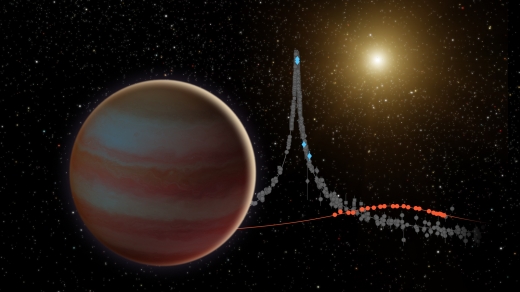
Image: This illustration depicts a newly discovered brown dwarf, an object that weighs in somewhere between our solar system’s most massive planet (Jupiter) and the least-massive-known star. This brown dwarf was discovered when it and its star passed between Earth and a much more distant star in our galaxy. This created a microlensing event, where the gravity of the system amplified the light of the background star over the course of several weeks. Credit: NASA/JPL-Caltech.
Combining the data and including observations from ground-based instruments allows scientists to make a call on the mass of the brown dwarf, between 30 and 65 Jupiter masses. The brown dwarf orbits a K-class star with about half the mass of the Sun. But focus on this: One of two possible distances between brown dwarf and star is 0.25 AU, which would put the object in what is known as the brown dwarf desert. The latter is a reference to the fact that stars of about the Sun’s mass rarely have a brown dwarf orbiting within 3-5 AU.
We don’t know for sure because there are two solutions to the distance question, the second being 40-52 AU. The paper notes that the Swift satellite is not distant enough from the Earth to allow for a separate measurement of the microlensing parallax, which would have made it possible to refine the distance measurement further. We get two solutions for the projected separation of brown dwarf and star, a well-known problem called close-wide degeneracy in which the perturbation patterns of close and wide objects can appear similar.
But if the 0.25 AU distance is correct, it would add to mounting evidence that the so-called ‘desert’ may be a mirage. For it turns out that OGLE-2015-BLG-1319 is hardly the first brown dwarf found through microlensing. In fact, there have been 15 published microlensing events involving brown dwarfs before this one, including one that hosted a planet, ten brown dwarfs around main sequence stars (with nine around M-dwarfs and one around a G-K class star), two binary brown dwarfs and two isolated brown dwarfs. In about half of these we also have questions about the distance between brown dwarf and star, but note this from the paper:
…the accumulation of detections suggests that BDs around main-sequence stars are not rare at separations of 0.5-20 AU, where microlensing is sensitive (this range is larger than for exoplanets due to higher detection sensitivity). This is in contrast to estimates through other techniques, such as radial velocity and transit, who find that BDs are rare (< 1%, Grether & Lineweaver 2006) at closer separations.
What to make of this? The paper continues:
One possible explanation for this difference, as suggested by Shvartzvald et al. (2016), is the different host stars that are mostly probed by each technique — FGK stars by radial velocity and transits versus M stars by microlensing.
Or as lead author Yossi Shvartzvald (JPL) puts it in this JPL news release:
“We want to understand how brown dwarfs form around stars, and why there is a gap in where they are found relative to their host stars. It’s possible that the ‘desert’ is not as dry as we think.”
The paper is Shvartzvald et al., “First simultaneous microlensing observations by two space telescopes: Spitzer & Swift reveal a brown dwarf in event OGLE-2015-BLG-1319,” Astrophysical Journal Vol. 831, No. 2 (7 November 2016). Abstract / preprint.

New Imaging of Protoplanetary Disks
Our knowledge of protoplanetary disks around young stars is deepening. This morning we have news of three recently examined disks, each with features of interest because we know so little about how such disks evolve. What we do know is that planets are spawned from the gas and dust we find within them, as we see in the disk below discovered using the SPHERE instrument on the European Southern Observatory’s Very Large Telescope in Chile.
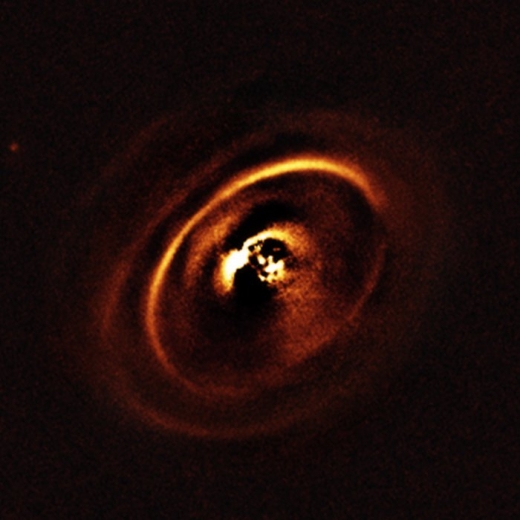
Image: A team of astronomers observed the planetary disc surrounding the star RX J1615, which lies in the constellation of Scorpius, 600 light-years from Earth. The observations show a complex system of concentric rings surrounding the young star, forming a shape resembling a titanic version of the rings that encircle Saturn. Such an intricate sculpting of rings in a protoplanetary disc has only been imaged a handful of times before. Credit: ESO, J. de Boer et al.
The comparison with Saturn is not amiss, for this is a complex system of concentric rings that is uncommon among protoplanetary disks we’ve found so far. While dating such systems is difficult, astronomers believe this disk is a bit less than 2 million years old. Bear in mind that we’re still trying to work out the mechanisms that cause these sculpted effects. They’re surely the result of planets in formation, but it’s worth noting that while the disk around RX J1615 is strikingly regular, we’re just as likely to encounter gaps, voids and spiral arms in such disks.
The work here is from Jos de Boer (Leiden Observatory), who has put the SPHERE instrument to good use. SPHERE (Spectro-Polarimetric High-contrast Exoplanet REsearch) was built as a planet imager, one that would take direct images of exoplanets rather than detecting them through their star’s Doppler shifts or through transits of the planet. An advanced coronagraph, SPHERE blocks out the central star, using a polarimetric differential imaging mode that draws on the fact that the light of the star is unpolarized, while the light scattered by the disk is polarized, allowing sharp images of the disk to be extracted.
Another researcher from Leiden University, Christian Ginski, is behind work on a different young system. The star is HD 97048, about 500 light years from Earth. Here again we see a striking symmetry in the ring system. Four gaps and rings can be found here. But finding any planets that are sculpting this system is not going to be easy, as the paper on this work notes:
We find that nascent planets are one possible explanation for the structures that we are observing. However, given the low planet masses needed to carve out the gaps that we detected, it is unlikely that the planet’s thermal radiation is directly detectable by current generation planet search instruments such as SPHERE or GPI [Gemini Planet Imager]. This conclusion is strengthened by the fact that the gaps are most likely not completely devoid of material and thus any thermal radiation from a planet inside the gap would be attenuated by the remaining dust.
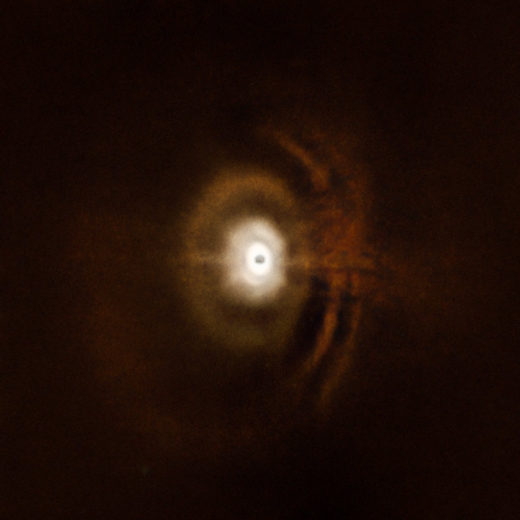
Image: The planetary disc surrounding the star HD 97048 in the constellation of Chameleon, about 500 light-years from Earth. The juvenile disc is formed into concentric rings. This symmetry is in contrast to most protoplanetary systems which contain asymmetrical spiral arms, voids and vortexes. The displayed image is a composite derived from two independent observations that targeted the inner and outer regions of this disc. The central part of the image appears dark because SPHERE blocks out the light from the brilliant central star to reveal the much fainter structures surrounding it. Credit: ESO, C. Ginski et al.
Contrast the two disks above with what Tomas Stolker and colleagues (Anton Pannekoek Institute for Astronomy, the Netherlands) have found. In the image below, we’re looking at HD 135344B, some 450 light years from Earth. Here the disk is obviously asymmetrical, consisting of a central cavity and two spiral arms thought to be the result of planet formation.
And in this system we have a feature that changed noticeably in the months between observing periods. The feature in question is one of the dark streaks that are evidently shadows created by material in motion within the protoplanetary disk. Planetary evolution in real time? That’s what this ESO news release calls it, an indication of the level of detail we can pick out in the inner disk regions of some stars with the SPHERE instrument.
The paper puts the matter this way:
The variable or transient nature of this shadow could be explained by several scenarios, including a local perturbation of the inner disk or an accretion funnel flow from the inner disk onto the star.
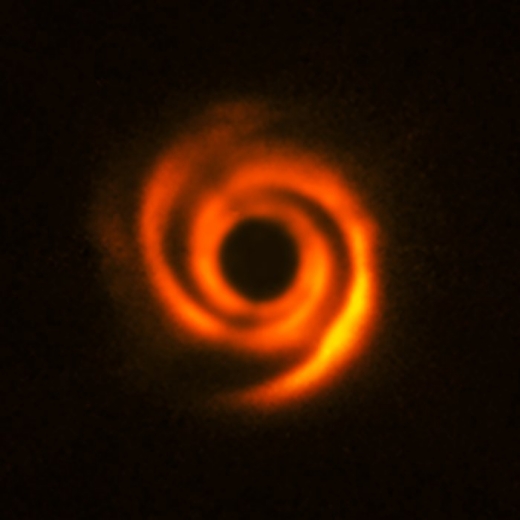
Image: The planetary disc surrounding the star HD 135344B, about 450 light-years away. The disc shows prominent spiral arm-like structures. Credit: ESO, T. Stolker et al.
In any case, we’re seeing change within months in this evolving system. And as to the spiral arms themselves:
An explanation for the spiral arms could not be uniquely determined. In the context of linear perturbation theory, the spiral arms are best explained by two protoplanets orbiting exterior of the spiral arms. Protoplanet solutions inside the scattered light cavity seem unlikely because the spiral arm pitch angles would require unphysical disk temperatures.
Understanding how planets shape the disks from which they form is a step forward in planet formation theory, and it’s clear that the environment of young systems like these is complex and varied enough to produce a wide range of outcomes in the evolving disk.
The papers are de Boer et al., “Multiple rings in the transition disk and companion candidates
around RX J1615.3-3255. High contrast imaging with VLT/SPHERE,” Astronomy & Astrophysics 595 (2016), A114 (preprint). On HD 97048, the paper is Ginski et al., “Direct detection of scattered light gaps in the transitional disk around HD 97048 with VLT/SPHERE,” accepted for publication at Astronomy & Astrophysics (preprint). The paper on HD 135344B is Stolker et al., “Shadows cast on the transition disk of HD 135344B,” accepted at Astronomy & Astrophysics (preprint).

Proxima Centauri Observations Launch Parkes Effort
In the last two days we’ve looked at a discussion of a possible SETI observable, a ‘shielding swarm’ that an advanced civilization might deploy in the event of a nearby supernova. As with Richard Carrigan’s pioneering searches for Dyson swarms in the infrared, this kind of SETI makes fundamentally different assumptions than the SETI we’ve grown familiar with, where the hope is to snag a beacon-like signal at radio or optical wavelengths. So-called ‘Dysonian SETI’ assumes no intent to communicate. It is about observing a civilization’s artifacts.
Both radio/optical SETI and this Dysonian effort are worth pursuing, because we have no idea what the terms of any discovery of an extraterrestrial culture will be. The hope of receiving a deliberate signal carries the enthralling possibility that somewhere there is an Encyclopedia Galactica that we may one day gain access to, or at the least that there is a civilization that wants to talk to us. A Dysonian detection would tell us that civilizations can survive their youth to become builders on a colossal scale, pushing up toward Kardashev levels II and III.
Keeping both SETI tracks engaged is good science. It’s encouraging on the radio front to see that the Parkes radio telescope in Australia has now joined the Green Bank Telescope (West Virginia) and the Automated Planet Finder (Lick Observatory) in SETI observations funded by Breakthrough Listen. A key component of the Breakthrough Initiatives effort (which includes Breakthrough Starshot), Breakthrough Listen has just announced the activation of its SETI project at Parkes with observations of the newly discovered planet around Proxima Centauri.
About this study, several points. First, Parkes marks a welcome expansion of the northern hemisphere efforts. Situated about 20 kilometers north of the town of Parkes in New South Wales, the telescope can observe those parts of the sky that are not visible to its northern counterparts, making it a major component in any comprehensive SETI effort.
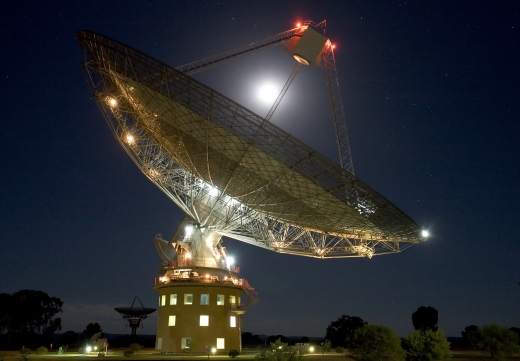
Image: The Parkes radio telescope in New South Wales. Credit: CSIRO.
As to Proxima Centauri, we now have an Earth-sized planet orbiting in what appears to be its habitable zone, meaning that temperatures could allow liquid water to exist on its surface. The discovery of Proxima b has enlivened the interstellar community as we examine ways to learn more about it, including the Breakthrough Starshot flyby probe studies. But I think we can agree that the chances of finding a civilization on any particular planet are low.
So says Andrew Siemion, director of the Berkeley SETI Research Center and leader of the Breakthrough Listen science program. And he adds:
“…once we knew there was a planet right next door, we had to ask the question, and it was a fitting first observation for Parkes. To find a civilisation just 4.2 light years away would change everything.”
It was in the same spirit that a number of SETI instruments have been turned to Boyajian’s Star (KIC 8462852), whose unusual light curves have drawn a great deal of attention because we have so far been unable to explain them. In both cases, we have a high-interest target, in the Proxima system because of its sheer proximity to Earth and in the Boyajian’s Star system because one explanation for those light curves is intelligent engineering.
So I am all for examining Proxima Centauri even though I think the real action there will be in one day analyzing its atmosphere for signs of biosignatures. 14 days of commissioning and test observations at Parkes led up to the first observation of Proxima on November 8 (local time). The broader strategy is to continue the SETI effort at radio wavelengths across a wide range of targets, as listed in this Breakthrough Initiatives news release.
- All 43 stars (at south declinations) within 5 parsecs, at 1-15 GHz. Sensitive to the levels of radio transmission at which signals ‘leak’ from Earth-based radar transmitters (with available receivers).
- 1000 stars (south) of all spectral-types (OBAFGKM) within 50 parsecs (1-4 GHz).
- One Million Nearby Stars (south). In 2016-2017, first 5,000 stars; 1 minute exposure (1-4 GHz).
- Galactic plane and Center (1-4 GHz).
- Centers of 100 nearby galaxies (south declinations): spirals, ellipticals, dwarfs, irregulars (1-4 GHz).
- Exotic sources will include white dwarfs, neutron stars, black holes, and other anomalous natural sources (1-4 GHz).
Bear in mind as these efforts proceed that Breakthrough Listen will also be coordinating searches with the FAST (Five hundred meter Aperture Spherical Telescope) in southwest China, exchanging observing plans, search methods and data. Thus we move toward a global SETI effort that can quickly share promising signals for analysis. Data from Parkes and the other Breakthrough Listen telescopes will be made available to the public online.

‘Shielding Swarms’ & SETI Observables
If you’re on the Moon and learn that there has been a major solar eruption, your best course of action is to get inside an appropriate shelter somewhere below ground, where you can be shielded from its effects. By analogy, wouldn’t a future civilization on Earth be able to shield itself from the effects of a supernova or gamma ray burst by burrowing into the planet?
In their paper on stellar explosions and risk mitigation, Milan ?irkovi? and Branislav Vukoti? argue against the idea, which runs into problems on multiple levels. For one thing, while the duration of gamma ray emissions is generally short — on the order of a hundred seconds or less — the pulse of accelerated cosmic rays from a supernova or GRB blast is likely to last much longer, perhaps a matter of months or even years.
Digging to avoid the worst of the effects would take you deep into the ground indeed. The authors cite work showing that you would need to burrow up to 3 kilometers below the surface before the incoming flux would drop to 1% of its initial value. And finally, Earth’s atmosphere could not itself be shielded this way, opening the door to ecological catastrophe.
A system-wide infrastructure involving asteroid mining and perhaps planetary colonies is likewise at risk. For all these reasons, ?irkovi? and Vukoti? think a future or extraterrestrial civilization would choose space-based shielding in its own planetary system as a response to the threat of any nearby stellar explosion. Here the most natural building material is ice, found in great abundance in the outer Solar System. What emerges is the concept of a ‘shielding swarm’ far from the Sun whose bulk density can be adjusted as necessary.
Here the notion of ‘smart dust’ inevitably occurs, which gives us a way of describing the swarm:
…we envision a swarm of particles confined by electromagnetic forces interspersed by smart dust particles controlling the swarm and enabling more precise manipulation, in addition to controlling ionization necessary for the ice particles to be moved around. They could provide essential telemetric information and the data on conditions within the swarm necessary for self-regulation actions. Since various forms of carbon, including fullerenes, is currently thought to be the best material for building smart dust, as well as other nanotechnological applications [89], and the Kuiper Belt objects are carbon-rich, it seems natural to assume that fragmentation of the very same icy body or bodies creating the bulk of the shielding swarm might provide material for construction of smart dust particles as well.
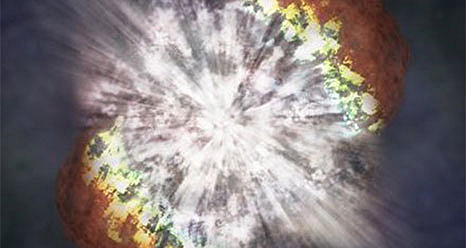
Image: Artist’s impression of a supernova blast. Credit: NASA.
So let’s drop back to the core idea. Assuming a threatening source can be identified and its likely explosion predicted, an advanced civilization could choose the appropriate icy objects and change their orbit to reach the staging area, where construction of the swarm can begin. Such a swarm could itself reduce cosmic ray flux by several factors, while additional active shielding could be provided by the same system of electromagnetic confinement that would be used to manipulate the particles in the swarm during its formation.
Searching for Extraterrestrial Technology
When contemplating what an extraterrestrial civilization might do (or indeed, what we might ourselves do when we reach a sufficient technological level), it’s useful to consider the thought processes involved. Freeman Dyson is relevant here — we are saying that anything we can hypothesize about our own future course should apply to at least some extraterrestrial species. This is how, without understanding the intricacies of a future technology, we can make broad predictions about possible astroengineering and how we might detect it.
Searching for Dyson swarms or spheres is an example of this, the search being motivated by our belief that such a swarm would be an intelligent way of maximizing energy resources for a society around a particular star. The fact that we can imagine it — although we are a long way from being able to do it — means that more advanced cultures have probably run across the same idea, given that it contradicts no physical laws. Thus it is at least worth the attempt to figure out what a Dyson swarm would look like if we stumbled across one in our data.
In a similar way, ?irkovi? and Vukoti? believe, it would be rational for any society to attempt to reduce large-scale risk, in this case in the event of the explosion of a close supernova. Shielding swarms of the kind the duo discuss in their paper are an extrapolation of what we, as a Kardashev 0.7 culture, might do if we had the energy and resources. Nudging forward into Kardashev 1 and beyond, we might look for signs of the presence of such swarms as a potential SETI signature around other stars. The paper suggests these possible observables:
- Planetary size structures with unusually small mass and non-Keplerian motion. In other words, find something the size of a terrestrial planet but with a mass as little as 10-8 Earth mass and suspicion should mount that it is an artifact.
- A swarming shield made predominately of ice may show unusual optical properties like polarization and non-equilibrium temperatures, as well as strong absorption in the far infrared. And this is interesting — a shield that is transiting its star would produce a small optical transit depth but a much larger infrared transit depth.
- Continuing fragmentation of small bodies in a planetary system without accompanying physical causes (collisions), along with anomalous loss of kinetic energy and momentum.
- Unusual observables in a planetary system occurring simultaneously with the last phases of evolution of a nearby supernova progenitor.

Image: The above two photographs are of the same part of the sky. The photo on the left was taken in 1987 during the supernova explosion of SN 1987A, while the right hand photo was taken beforehand. Supernovae are one of the most energetic explosions in nature, equivalent to the power in a 1028 megaton bomb (i.e., a few octillion nuclear warheads). Credit: NASA.
A shielding swarm of ice particles with infused ‘smart dust’ is attractive on a number of levels, not the least being that we can think of no physical laws such a swarm would violate, in sharp contrast to issues like faster than light travel or even the problems attendant on building a solid Dyson sphere (as opposed to a shell). The materials involved in a shielding swarm are those that would be available to any growing technology, and the construction and maintenance of such a swarm would be inexpensive to an advanced spacefaring culture.
…we conclude that successful mitigation of cosmic explosions risk is viable for sufficiently advanced technological societies, both future terrestrial and extraterrestrial. We suggest that building and maintaining shielding swarms of small particles/components is (relatively!) cheap and efficient way of achieving that goal and creating a durable planetary and interplanetary civilization. The technology required partially overlaps with that required for mitigation of asteroid/cometary impact risk, which could provide some clues for future technological desiderata and even convergence. Finally, this new type of macro- or astroengineering could not only enrich the spectrum of astroengineering possibilities, but also provide another opportunity for bold and innovative SETI programs to detect advanced technological civilizations elsewhere in the Galaxy.
Thus we have a possible new astroengineering signature to look for, and on that score, I think back to something Freeman Dyson said in a 1966 essay called “The Search for Extraterrestrial Technology.” Here he explains his view that if there are millions of places in the universe where light might develop, then we should not be thinking about average technological societies but those that are the most conspicuous. It is these we have the best chance to detect, and they will be the ones doing the biggest possible artificial activities.
Can we really rely on our extrapolations from our own technology to study this question? Here’s how Dyson stated the answer:
I assume that all engineering projects are carried out with technology which the human species of the year 1965 A.D. can understand. This assumption is totally unrealistic. I make it because I cannot sensibly discuss any technology which the human species does not yet understand. Obviously a technology which has existed for a million years will be likely to operate in ways which are quite different from our present ideas. However, I think this rule of allowing only technology which we already understand does not really weaken my argument. I am presenting an evidence proof for certain technological possibilities. I describe crude and clumsy methods which would be adequate for doing various things. If there are other more elegant methods for doing the same things, my conclusions will still be generally valid.
The paper is ?irkovi? and Vukoti?, “Long-term prospects: Mitigation of supernova and gamma-ray burst threat to intelligent beings,” accepted at Acta Astronautica. No preprint yet available but I’ll insert it when it appears. The Dyson paper I quote above is F.J. Dyson, “The search for extraterrestrial technology,” in: R.E. Marshak (Ed.) Perspectives in Modern Physics, Interscience Publishers, New York, 1966, pp. 641–655.

Risk Mitigation for Advanced Civilizations
Alastair Reynolds’ 2008 novel House of Suns contains what must be the most outrageous solution for an endangered civilization I’ve ever encountered. Set some 6 million years in the future, the story involves technologies at the Kardashev Type III level — in other words, civilizations that are capable of harnessing the energy of entire galaxies. At one point, a supermassive star whose pending death threatens a local civilization is enclosed in an enormous ‘stardam,’ made out of remnant ‘ringworlds’ from a long-lost culture that litter the galaxy.
I believe we’re normally considered to be at about Kardashev level 0.7, so a feat like this is utterly the stuff of science fiction, but in Reynolds’ hands it makes for a robust tale. Here’s how future humans discuss it in the novel:
To dam a star, to enclose it completely, would require the construction of a Dyson shell. Humans can shroud a star with a swarm of bodies, a Dyson cloud, but we cannot forge a sphere. Instead we approximate one by surrounding a star with thousands of ringworlds, all of similar size but with no two having exactly the same diameter. We make a discus and then start tilting, until each ringworld is encircling the star at a unique angle. The light of the star rams through the narrowing gaps as the ringworlds tighten into their final orientation. Shutters close on a fierce, deadly lantern.
And there you are — what would have been death by supernova becomes averted as the energies of the dying star bounce back and forth between these myriad reflecting surfaces until over aeons, they gradually leak out as infrared. If this seems surreal, the novel even trumps the stardam with a star (in the Andromeda galaxy) completely enclosed in a representation of the Platonic Solids. To learn how this came about, I send you to Reynolds, for whom I’ve developed great admiration in the last five or six years. This is an author whose concepts are big enough to call up Olaf Stapledon and Star Maker (1937).
The Threat from Exploding Stars
I was delighted to see that Milan ?irkovi?, whose work we’ve looked at frequently in these pages, mentions House of Suns in his new paper, slated to appear in Acta Astronautica. ?irkovi? (Astronomical Observatory, Belgrade) has been a key player in the definition and exploration of so-called Dysonian SETI, which involves moving beyond radio and optical wavelengths to consider the possible signature that a truly advanced civilization might leave through its activities, which do not necessarily involve communication.
We looked last summer at the possibility of ‘stellified’ objects, in a ?irkovi? paper that considered the manipulation of a gas giant or even a brown dwarf to extract energy, and the SETI observables this might create (see SETI: Detecting ‘Stellified’ Objects, or Rethinking SETI’s Targets). The new work, written with Branislav Vukoti? (University of Oxford) looks at the response by an advanced civilization to threats from supernovae and gamma ray bursts (GRBs), with the nod toward the Reynolds novel coming in as an extreme response by what the paper refers to as humanity++, a civilization capable of interstellar flight and engineering at the interstellar level. This is a culture that may be biological or not, but it is one capable of changing its environment at large scales of space, time and energy.
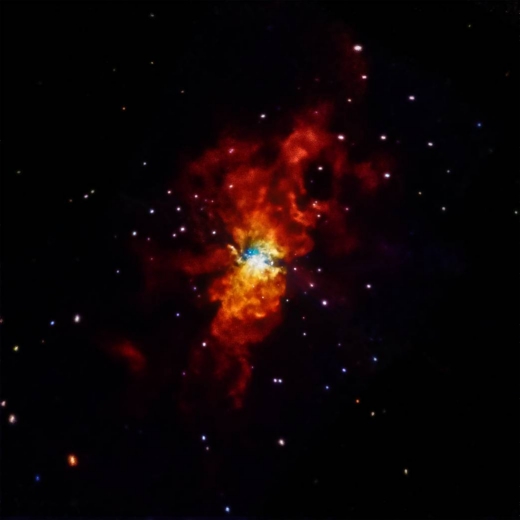
Image: On January 21, 2014, astronomers witnessed a supernova soon after it exploded in the Messier 82, or M82, galaxy. Telescopes across the globe and in space turned their attention to study this newly exploded star, including Chandra. Astronomers determined that this supernova, dubbed SN 2014J, belongs to a class of explosions called “Type Ia” supernovas. These supernovas are used as cosmic distance-markers and played a key role in the discovery of the Universe’s accelerated expansion, which has been attributed to the effects of dark energy. Scientists think that all Type Ia supernovas involve the detonation of a white dwarf. One important question is whether the fuse on the explosion is lit when the white dwarf pulls too much material from a companion star like the Sun, or when two white dwarf stars merge. Credit: NASA/CXC/SAO/R.Margutti et al.
All of this makes for fascinating speculation on the SETI level, and I intend to get to that in a subsequent article, but the bulk of the new ?irkovi? paper deals with the far-future scenario by way of contrasting it with a culture not terribly more advanced than our own. The author dubs it humanity+, a civilization perhaps of the Kardashev 1 level or a bit beyond, that is capable of using the resources of the Solar System for industrial purposes, asteroid mitigation, exploration and colonization. This is a culture we could, barring various forms of intervening catastrophe, imagine emerging on and from our planet within centuries.
The question becomes, would a culture that had the means to do it protect itself against existential risk in the form of supernovae and GRBs? We’re currently just learning about what we can do to respond to the threat of impacts on Earth, by studying asteroids and comets to learn how we might alter a dangerous trajectory. We’re also learning about hazards like supervolcanoes, and the ways in which such activity has altered our planet in the past.
Supernovae and gamma ray bursts present what seems to be an entirely different kind of threat, and one that seems to play out on a galactic timescale. GRBs have been considered by some authors as offering a regulation mechanism preventing the spread of life in the distant past of the Milky Way, and it’s interesting that cosmic explosion rates have generally been declining over cosmic time, as shown in cosmological observations and models of star formation. I am not aware of any previous risk analysis on GRBs or supernovae of the sort that ?irkovi? and Vukoti? undertake here, but the paper explains why this is understandable.
While we already have an extensive literature on impact prediction and mitigation, one reason for our attention is the existence of recent evidence, such as the 2013 Chelyabinsk air burst and the 1908 explosion that levelled thousands of acres in Siberia, not to mention our growing understanding of the Late Heavy Bombardment’s effects on the primordial Earth.
Likewise, supervolcanism has been little studied until recently, but while its effects may litter our past, we can also relate it to catastrophic eruptions in our own era, like Krakatoa in 1883 or Mount Tambora in 1815. Supernovae and GRBs are hardly as visible, but we do have reason to believe they can have disastrous effects on a nearby biosphere, and some researchers have argued for certain extinctions in Earth’s history to be the result of nearby cosmic explosions.
Will the threat of such catastrophes drive a future civilization to study mitigation efforts to prevent the worst of their effects? We have to consider the question in long timescales indeed:
…it is reasonable to assume – Earth’s single case notwithstanding – that evolving intelligent beings, not to mention technological civilizations, requires timescales on the order of several Gyr, during which a single close explosion could cut or derail the evolutionary chain of events leading to that outcome, this indicates that once a civilization emerges, it is only rational to seriously consider risk from such events and possibilities of its mitigation.
The paper goes on to refer to simulations reported within its pages by author Vukoti?:
While the resolution of the simulation of Vukoti? et al. is still insufficient for conclusions about number of individual stars and planetary systems, it is still indicative and motivating for further work in the area. For the present purposes, we note that no part of any spiral galaxy can be considered safe from cosmic explosions in the long run. And as the timeframe considered by an intelligent species grows longer, more relevant becomes the issue of mitigation. It is reasonable to hope that near-future simulations of habitability will offer more complete and precise account of the amount of risk faced by different parts of the Galactic Habitable Zone.
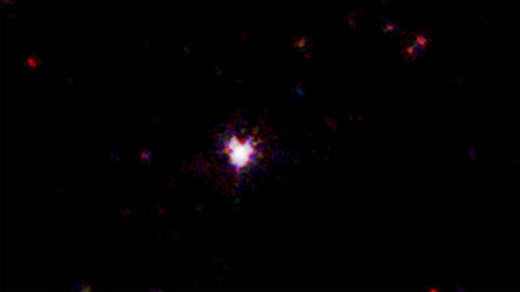
Image: GRB 111209A exploded on Dec. 9, 2011. The blast produced high-energy emission for an astonishing seven hours, earning a record as the longest-duration GRB ever observed. This false-color image shows the event as captured by the X-ray Telescope aboard NASA’s Swift satellite. Credits: NASA/Swift/B. Gendre (ASDC/INAF-OAR/ARTEMIS).
Timing the Event
Mitigation of the damage from a cosmic explosion would seem to be an impossibility, given our lack of knowledge of when one is going to occur. We would need to know not just where the explosion was centered but how strong it would be, and as the paper points out, how isotropic in terms of its emissions. We’re a long way in terms of supernovae, not to mention GRBs, from being able to work out timeframes for the explosion of even nearby stars like eta Carinae. Our present-day technology could do nothing to reduce the effects of a cosmic explosion, but ?irkovi? and Vukoti?, remember, are speculating about a future humanity.
This is a civilization moving past Kardashev Level I that has learned a great deal more than we know about supernovae and GRBs, and the authors see no reason in principle why explosion times, energies, spectra, cosmic-ray acceleration power and other factors for these phenomena will not eventually be much better understood. Prediction is an essential, and while we are well on the way toward predicting dangerous asteroid encounters, we have much to do before we reach the level of understanding that GRB mitigation would involve.
While prediction of weather in its local detail is still notoriously uncertain, the trajectory and timing of hurricanes, cyclones and other storm systems storms is today routinely predicted, often enough in advance for efficient mitigation measures to be deployed. History of science offers many examples of the increase of reliability and accuracy of predictions in various other areas, from eclipses to neutrino pulse from supernova SN 1987 A. Even in the areas where predictions have not built a good track record so far (e.g., earthquakes, volcanic eruptions, economic crises), we are gradually focusing on the main obstacles to further progress and the development of massive numerical simulations did much to understand the related problems much better.
If such prediction could be mastered, then we or some hypothetical extraterrestrial civilization could investigate how to protect our planet or entire planetary system from the effects of a cosmic explosion. What kind of technologies would this most likely involve, and what kind of signature might it leave in our astronomical data? We’ll look at the possibilities tomorrow.
Centauri Dreams’ take: Learning how to predict events like these may be well beyond our understanding, but it is not unreasonable to think that a sufficiently advanced civilization may have found ways to assess their likelihood. Dysonian SETI looks at technologies, Dyson swarms being a classic example, that do not contradict physical law but are beyond conceivable human engineering. It makes sense to consider possible signatures of advanced civilizations even though we are ourselves unable to duplicate them. Thus I agree with ?irkovi? and Vukoti? on this point from their paper:
It is important to emphasize from the outset that while details of the interaction of cosmic explosions with biospheres are still largely unknown, they are of minor importance for the central goal of this paper. As Ludwig Boltzmann [71] famously said: “It may be objected that the above is nothing more than a series of imperfectly proved hypotheses. But granting its improbability, it suffices that this explanation is not impossible. For then I have shown that the problem is not insoluble, and nature will have found a better solution than mine.” [present authors’ emphasis] We would add only that “nature” here should be expanded to encompass actions of advanced technological civilizations – which may or may not be recognizable as such.
The paper is ?irkovi? and Vukoti?, “Long-term prospects: Mitigation of supernova and gamma-ray burst threat to intelligent beings,” accepted at Acta Astronautica. See also Vukoti? et al., “‘Grandeur in this view of life'”: N-body simulation models of the Galactic habitable zone,” Monthly Notices of the Royal Astronomical Society published online 12 April 2016 (abstract / preprint).

A Dazzling Galactic Encounter
Sometimes deep sky objects are so striking that I have no choice but to write about them, even if they weren’t on the agenda for today. 114 million light years from Earth in the direction of Canis Major we see an interacting pair of galaxies. Michele Kaufman (Ohio State University) and colleagues have found arcs of star formation here that give the visual impression of eyelids. They’re evidence of an encounter between the two galaxies, one brought into vivid focus by the Atacama Large Millimeter/submillimeter Array (ALMA).
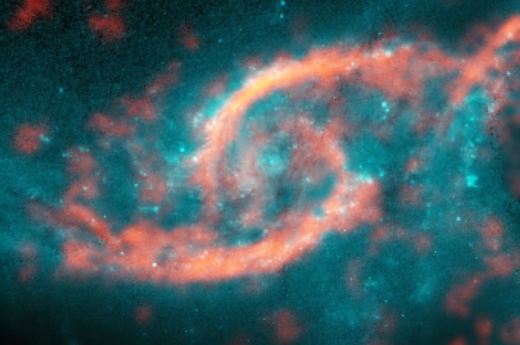
Image: Dazzling eyelid-like features bursting with stars in galaxy IC 2163 formed from a tsunami of stars and gas triggered by a glancing collision with galaxy NGC 2207 (a portion of its spiral arm is shown on right side of image). ALMA image of carbon monoxide (orange), which revealed motion of the gas in these features, is shown on top of Hubble image (blue) of the galaxy. Credit: M. Kaufman; B. Saxton (NRAO/AUI/NSF); ALMA (ESO/NAOJ/NRAO); NASA/ESA Hubble Space Telescope.
We have no head-on collision here, but by studying the motion of carbon monoxide gas in the ‘eyelid’ features, the astronomers can determine that two galaxies have merely brushed past each other, with the star arcs blooming in the galaxy IC 2163 after its encounter with galaxy NGC 2207. The gas in the outer part of the IC 2163 ‘eyelid’ is moving inward at over 100 kilometers per second, but deceleration is rapid and the gas eventually aligns with the rotation of the galaxy. The close pass that drew out these waves of material is thought to be the first encounter in what will eventually become a merger of the two galaxies.
The imagery prompts Bruce Elmegreen (IBM Watson Research Center, Yorktown Heights NY), one of the paper’s co-authors, to compare the waves of star formation to massive ocean waves moving in toward shore that stay more or less intact until they hit shallow water, when they lose their momentum and pour onto the beach. The ocular look of the encounter is striking but not completely uncommon, with other examples of eye-like structures having been identified with much the same causes. Michele Kaufman comments on the process:
“Not only do we find a rapid deceleration of the gas as it moves from the outer to the inner edge of the eyelids, but we also measure that the more rapidly it decelerates, the denser the molecular gas becomes. This direct measurement of compression shows how the encounter between the two galaxies drives gas to pile up, spawn new star clusters and form these dazzling eyelid features.”
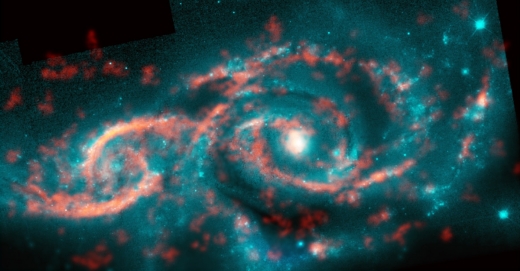
Image: Galaxies IC 2163 (left) and NGC 2207 (right) recently grazed past each other, triggering a tsunami of stars and gas in IC 2163 and producing the dazzling eyelid-like features there. Here we can see both galaxies. As in the image above, the ALMA image of carbon monoxide (orange), which revealed motion of the gas in these features, is shown on top of the Hubble image (blue) of the galaxy pair. Credit: M. Kaufman; B. Saxton (NRAO/AUI/NSF); ALMA (ESO/NAOJ/NRAO); NASA/ESA Hubble Space Telescope.
The ocular structure develops in simulations of galaxy encounters and has been studied since the early 1990s, when it became clear that a close encounter with a galaxy of similar mass causes a disk galaxy to develop two long tidal arms. The resulting ocular structure lasts only a few tens of millions of years, making finding a newly formed example a rarity.
Observing galaxy pairs like this gives us a chance to test the physics we have been modeling for years. In the excerpt from the paper that follows, both N-body simulations (simulations of the dynamics of particles under forces like gravity) and SPH, or Smoothed-particle Hydrodynamic simulations (simulating liquid flows) are brought to bear on the question:
In the encounter simulations, IC 2163 suffers a prograde, nearly in-plane encounter as it passes, mainly southward, behind NGC 2207 (relative to us), and its ocular structure forms from outer disk material that loses angular momentum in the tidal perturbation, flows inward until it hits an angular momentum barrier, piles up in the eyelids, and produces a shock zone there. Although in the SPH model by Struck et al. (2005), the outer disk of IC 2163 initially side-swipes the outer disk of NGC 2207, the ocular shock zone is not the result of direct contact between the two galaxies but develops later from the prolonged prograde encounter.
What we learn from the ALMA work is that the observed velocities of the molecular gas in the eyelid features line up with the predictions of computer models, a key test for their evaluation. “This evidence for a strong shock in the eyelids is terrific,” says Curtis Struck (Iowa State University), one of the paper’s co-authors. “It’s all very well to have a theory and simulations suggesting it should be true, but real observational evidence is great.”
The paper is Kaufman et al., “Ocular Shock Front in the Colliding Galaxy IC 2163,” accepted at the Astrophysical Journal (preprint).


